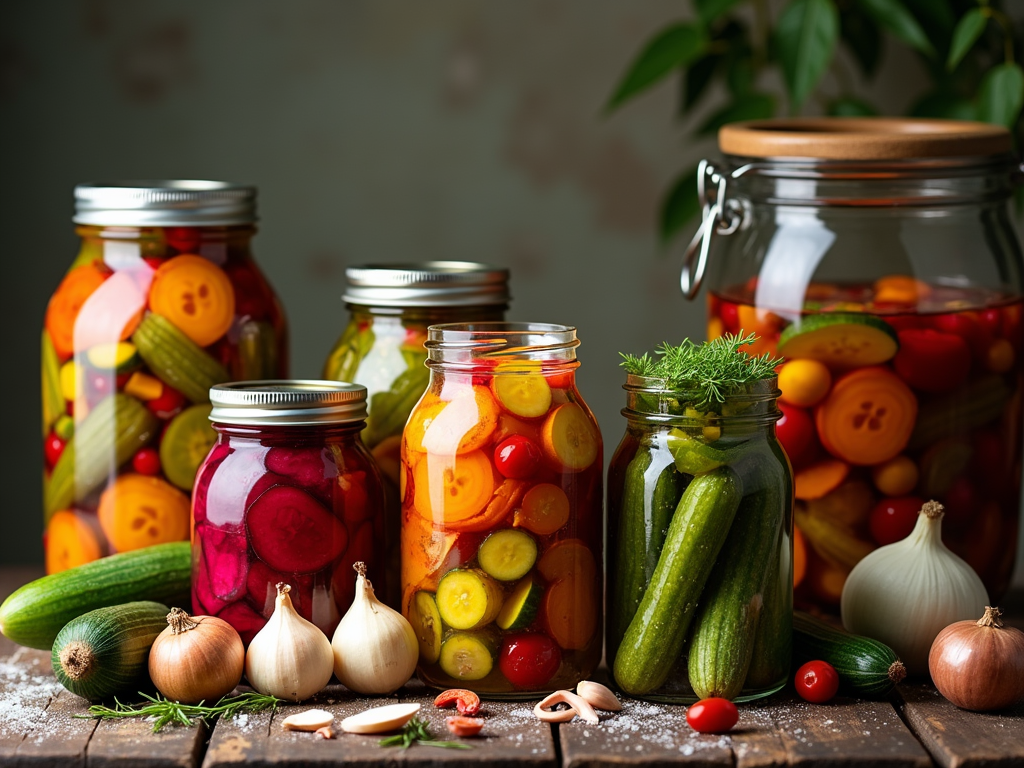
Natural food preservation methods keep food fresh longer while retaining nutrients and flavor. Techniques like drying, canning, fermentation, salting, and pickling prevent spoilage by managing moisture, acidity, and microbial activity.
Key Takeaways
- Drying removes moisture to stop bacteria from growing. Different foods require specific temperatures to stay safe and maintain flavor.
- Canning seals food in airtight containers, killing microorganisms. High-acid foods need water bath canning, while low-acid foods require pressure canning.
- Fermentation depends on beneficial bacteria converting sugars into acids. This preserves food and provides probiotics for gut health.
- Salting and brining extract moisture and create an environment where bacteria can’t thrive. These methods work well for meats, fish, and some vegetables.
- Pickling relies on acidity to prevent spoilage. Vinegar-based quick pickling extends freshness for short periods, while fermentation-based pickling preserves food longer.
How Drying Makes Food Last for Months
Pulling moisture out of food stops bacteria and mold from growing, making it last for months or even a year. Sun drying is an easy option if the weather cooperates—hot, dry, and breezy conditions work best. Spread food out on racks or screens and keep it covered with mesh to keep pests away.
Oven drying and electric dehydrators offer more control. Herbs dry best at 95-115°F, while vegetables need 125-135°F. Fruits require slightly higher temperatures, around 130-140°F, and meats should reach 145-155°F to ensure safety. Keeping food at the right temperature prevents spoilage and retains flavor and nutrients.
For food to stay preserved, its water activity (Aw) must drop below 0.6. This level halts microbial growth, and the moisture content should be reduced to 5-20%, depending on the food type. Properly dried foods store well in airtight containers away from heat and light.
If you’re looking for more options, drying works well alongside other long-term food preservation methods. It’s one of the easiest ways to save supplies for later while keeping flavor intact.

The Science Behind Canning and Why It Works
Canning locks food in airtight containers and applies heat to eliminate microorganisms that cause spoilage. Without oxygen and harmful bacteria, food stays safe for long-term storage. The process relies on two main methods: water bath canning and pressure canning.
Water Bath vs. Pressure Canning
Water bath canning works for high-acid foods with a pH of 4.6 or lower. Fruits, jams, jellies, and pickles fall into this category because acidity helps prevent bacterial growth. This method involves submerging jars in boiling water to kill unwanted microbes.
For low-acid foods above pH 4.6—like vegetables, meats, and seafood—pressure canning is the only safe choice. It heats food to 240-250°F (116-121°C), hot enough to destroy Clostridium botulinum spores, which thrive in low-acid environments. Without this step, improperly canned foods risk botulism, a dangerous illness.
Essential Equipment for Safe Canning
The right tools make all the difference in successful food preservation. Here’s what every canner needs:
- Canning jars, lids, and rings – Ensure a proper seal and prevent air from contaminating food.
- Water bath or pressure canner – Choose the right method based on the food’s acidity.
- Jar lifter – Safely handles hot jars to prevent burns.
- Bubble remover and headspace tool – Eliminates trapped air for a secure seal.
Canning requires strict attention to processing times and pressures. Done right, it keeps food fresh and safe for months or even years. Anyone looking to expand their food preservation skills should check out the Prepper’s Canning and Preserving Bible for expert guidance.
Fermentation: Preserving Food While Adding Health Benefits
Fermentation keeps food from spoiling while adding complex flavors and health benefits. It relies on beneficial bacteria, like lactic acid bacteria, to break down sugars into acids. This process creates an environment that harmful bacteria can’t survive in, naturally preserving food for weeks or even months.
Many common foods come from fermentation. Sauerkraut, kimchi, yogurt, kefir, kombucha, and sourdough bread all develop their signature flavors and textures through this method. Each uses different ingredients, but they all share the same basic principle—allowing good bacteria to thrive while keeping harmful ones at bay.
How Fermentation Works
The process starts by mixing fresh ingredients with salt at a ratio of 2-2.5% by weight. This concentration prevents unwanted bacteria from multiplying while allowing beneficial microbes to take over. The food then sits at room temperature, where natural bacteria begin converting sugars into acids. Depending on the food, fermentation can take anywhere from a few days to several weeks.
Beyond preservation, fermented foods improve gut health by introducing probiotics. These beneficial bacteria support digestion, boost immunity, and even enhance nutrient absorption. Fermentation delivers more than just longer shelf life—it also creates better-tasting, healthier food.
If you’re interested in storing food for extended periods, fermentation pairs well with other techniques like root cellaring. Combining methods ensures food stays safe and nutritious for months.

How Salting and Brining Keep Food Fresh for Longer
Salt has kept food fresh for centuries by pulling moisture out, creating an environment where bacteria struggle to survive. Dry salting and brining are the two main techniques, each working best for different types of foods.
Dry Salting
Dry salting involves coating food with salt, which slowly absorbs moisture. This works well for meats like bacon and prosciutto, as well as some vegetables. Over time, the salt helps preserve the texture and flavor while preventing spoilage.
Brining
Brining, on the other hand, requires submerging food in a saltwater solution. The concentration usually falls between 5-20% salt by weight, depending on the food being preserved. Fish, like salt cod, absorbs the brine, which keeps it safe to eat longer. Some vegetables also benefit from this method, where the salt encourages fermentation, turning them into pickled delicacies.
Preservation Benefits and Safety
Both methods allow food to last far beyond normal storage times. However, keeping cured meats at safe internal temperatures is key to preventing bacterial growth. Whether using salting or brining, these methods ensure food stays preserved without refrigeration.
For those looking into additional natural methods, learning how to preserve meat without refrigeration offers even more long-term options.

Pickling: The Power of Acidity in Preservation
Pickling keeps food from spoiling by using acidity to prevent harmful bacteria from growing. Submerging vegetables, eggs, or even fruits in vinegar— which typically has a pH below 4.6— creates an environment where bacteria can’t survive.
The key ingredient is vinegar, with at least 5% acetic acid to ensure safe preservation. Pickled cucumbers, onions, beets, and peppers last much longer than fresh produce and develop a bold, tangy flavor. Even eggs can be stored this way for extended periods.
There are two main methods: quick pickling and fermentation.
Quick Pickling vs. Fermented Pickles
A fast and simple way to pickle involves soaking food in vinegar-based brine and storing it in the refrigerator. This method retains a crisp texture and is ready in a matter of hours or days. These pickles aren’t shelf-stable but can stay fresh in the fridge for weeks.
Fermented pickles take a different approach. Instead of vinegar, salt and water encourage natural bacteria to produce lactic acid, creating a sour, complex flavor over time. This process can take a few days to weeks, depending on temperature and salt concentration.
Both methods enhance flavor and extend shelf life, making pickling a reliable way to store food without refrigeration. For those looking to preserve more delicate foods, learning about the best ways to preserve eggs long-term can be useful.

Sources:
National Center for Home Food Preservation
The Art of Fermentation by Sandor Ellix Katz
Putting Food By by Janet Greene, Ruth Hertzberg, and Beatrice Vaughan
USDA Complete Guide to Home Canning
